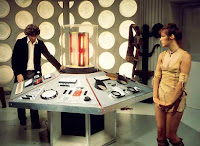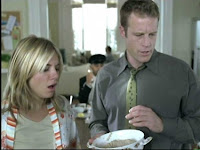 You noticed I said “us,” right? Lots of people think of Ex-Heroes as my first novel, but it wasn’t. There was Lizard Men from the Center of the Earth (two versions), a God-awful sci-fi novel called A Piece of Eternity, some Star Wars and Doctor Who fan fic, a puberty-fuelled fantasy novel (which I haven’t admitted to in twenty years or so), The Werewolf Detective of Newbury Street, The Trinity, The Suffering Map, about half of a novel called Mouth… and thenEx-Heroes. And I can tell you without question that most of those really sucked. It doesn’t mean I didn’t try to sell some of them (we’ll get to that in a minute), but I couldn’t improve as a writer until I accepted that I needed to improve.
You noticed I said “us,” right? Lots of people think of Ex-Heroes as my first novel, but it wasn’t. There was Lizard Men from the Center of the Earth (two versions), a God-awful sci-fi novel called A Piece of Eternity, some Star Wars and Doctor Who fan fic, a puberty-fuelled fantasy novel (which I haven’t admitted to in twenty years or so), The Werewolf Detective of Newbury Street, The Trinity, The Suffering Map, about half of a novel called Mouth… and thenEx-Heroes. And I can tell you without question that most of those really sucked. It doesn’t mean I didn’t try to sell some of them (we’ll get to that in a minute), but I couldn’t improve as a writer until I accepted that I needed to improve.Category: Suffering Map
August 15, 2013
Admissions Board
 You noticed I said “us,” right? Lots of people think of Ex-Heroes as my first novel, but it wasn’t. There was Lizard Men from the Center of the Earth (two versions), a God-awful sci-fi novel called A Piece of Eternity, some Star Wars and Doctor Who fan fic, a puberty-fuelled fantasy novel (which I haven’t admitted to in twenty years or so), The Werewolf Detective of Newbury Street, The Trinity, The Suffering Map, about half of a novel called Mouth… and thenEx-Heroes. And I can tell you without question that most of those really sucked. It doesn’t mean I didn’t try to sell some of them (we’ll get to that in a minute), but I couldn’t improve as a writer until I accepted that I needed to improve.
You noticed I said “us,” right? Lots of people think of Ex-Heroes as my first novel, but it wasn’t. There was Lizard Men from the Center of the Earth (two versions), a God-awful sci-fi novel called A Piece of Eternity, some Star Wars and Doctor Who fan fic, a puberty-fuelled fantasy novel (which I haven’t admitted to in twenty years or so), The Werewolf Detective of Newbury Street, The Trinity, The Suffering Map, about half of a novel called Mouth… and thenEx-Heroes. And I can tell you without question that most of those really sucked. It doesn’t mean I didn’t try to sell some of them (we’ll get to that in a minute), but I couldn’t improve as a writer until I accepted that I needed to improve.March 22, 2012 / 1 Comment
What is ‘Real’? How do You Define ‘Real’?
Pop culture reference. Easy one, cause it’s been awhile…
March 16, 2012 / 5 Comments
What Lies Beneath
First off, a little poll for all of you reading this. I’ve been thinking of taking a bunch of the posts here and making a condensed, somewhat more organized document that might pass as a book on writing. If I put something like that out in ebook format for $1.99 or so, would anyone have any interest in such a thing? I’m also thinking of pairing it with The Suffering Map, released as a cautionary tale about first novels, probably for just a buck. Does any of that sound vaguely interesting to anyone? Let me know in the comments section.
September 10, 2010
Alphabet Soup
Wow, is it Thursday again already? The three day weekend really threw off my schedule. You get used to things in a certain order and suddenly there’s Thursday, showing up a day early. You expect there to be a few more days in there, y’know…?
Anyway…
I don’t know about the rest of you, but most of my ideas tend to spark with small moments. It’s very rare that an entire story pops into my head fully-formed. I’ve had it happen with a few pieces of flash-fiction and maybe two short stories. For the most part, though, when I start writing something it tends to begin with a random snippet of dialogue or a clever scene of some kind. Then another one. And another. And so on and so forth.
Now, when it comes time to start organizing all of these, I end up with a rough outline of sorts. I say rough because I know there’s a lot of stuff that’s not there. I may have snappy dialogue A and clever reveal B which lead to action scene C, but all the stuff in between… well, there’s usually a lot of discovery in there that doesn’t come out until I start putting words on paper. For example, who would’ve guessed that Danielle’s baseball shirt would be so important in Ex-Patriots? I sure didn’t. I just realized the other day how it tied up a few things into a neat package.
However, there’s also times that I pound my head on the desk for hours trying to figure out what the hell goes between A and B. It can take ages but I usually find something. More often than not, it’s something I’m not thrilled with and it tends to be something that gets cut later.
Which is what I wanted to toss out to you.
If you’ve got A and B, what goes between them?
No, don’t overthink it. Just answer the question. What’s between A and B?
The answer is nothing, which is what a lot of people have trouble with. I had trouble with it for the longest time. Sometimes the reason nothing seems to fit or work between two plot points or story beats is because… well, nothing fits or works between them. There’s a reason no one ever talks about A.5 or A and 3/4.
This is very important in screenwriting, where the goal is to keep everything as lean and tight as possible. When a reader comes across a page of dialogue or action that’s just filler–and it will be apparent to a professional reader that it’s just filler–they’re going to toss that script in the big left hand pile. At the very least, they’re going to be swiveling their chair in that direction and waiting for the next excuse to toss it.
I’ve often mentioned my first real attempt at a novel, The Suffering Map. The first draft of it was bloated, and part of the reason is that I was convinced something had to happen between A and B. And between P and Q. And between V and W. At one point, because I was somehow convinced there needed to be time and space between two events, I had a Mafia boss discover the whereabouts of the guy who slaughtered three of his men and then decide to wait three days before sending people to extract vengeance. Three days that I had to fill up with unnecessary nonsense just because I knew there had to be something between that moment Uncle Louis learns about Rob and the bloody slaughter that followed.
What I eventually realized, though, was that Uncle Louis wasn’t the kind of guy to wait. There was nothing between A and B. Once I realized this and made a few sweeping cuts, the story was stronger and that whole sequence was much more powerful.
The same thing happened once or thrice in Ex-Heroes. I had a few points where characters would go on for a page with random dialogue or actions for no real reason except that I was convinced that there needed to be a break between this and that. Two of my early readers caught these moments and pointed out there was no reason R couldn’t come right after Q. It should come right after Q. That’s how the alphabet works, right?
Now, just to be clear, this doesn’t mean there should never be anything between story points. You may put them next to each other and end up scratching your head at the oddness you just created. Sometimes there really does need to be stuff separating A and B. However, that tells you something right there, doesn’t it? If this is the case, you’re not dealing with A and B, but A and C, or perhaps even A and D. Once you figure that part out, you now know how much needs to go between those two points you have.
So the next time you get stuck trying to figure out what needs to be between A and B, stop for a moment. Try putting your two plot points or story fragments next to each other and see what happens. You may discover you’ve got a solid connection already. At the very least, maybe you’ll get a better idea of what needs to be between them.
Next time, what happens when simple math tricks go wrong.
Until then, make a point to fill in all that blank space on the page. Go write.




